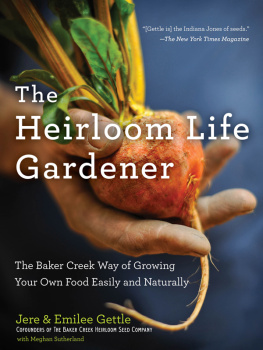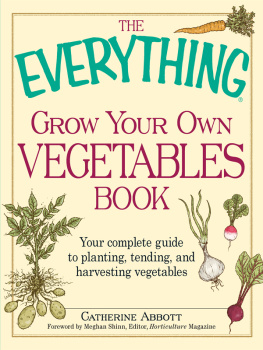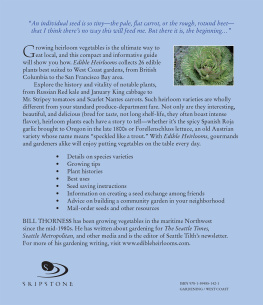THE BEGINNERS GUIDE
to growing
HEIRLOOM VEGETABLES

THE BEGINNERS GUIDE
to growing
HEIRLOOM VEGETABLES
The 100 Easiest-to-Grow,
Tastiest Vegetables for Your Garden
BY MARIE IANNOTTI

Frontispiece: The colors, shapes, and flavors of heirloom
vegetables are just a hint of the diversity available.
Photography credits appear on .
Copyright 2011 by Marie Iannotti. All rights reserved.
Published in 2011 by Timber Press, Inc.
The Haseltine Building
133 S.W. Second Avenue, Suite 450
Portland, Oregon 97204-3527
timberpress.com
2 The Quadrant
135 Salusbury Road
London NW6 6RJ
timberpress.co.uk
Printed in China
Library of Congress Cataloging-in-Publication Data
Iannotti, Marie.
The beginners guide to growing heirloom vegetables: the 100 easiest-to-grow, tastiest vegetables for your garden/Marie Iannotti.1st ed.
p. cm.
Includes bibliographical references and index.
ISBN 978-1-60469-188-7
1. Vegetable gardening. 2. VegetablesHeirloom varieties. I. Title.
SB321.I36 2012
635dc23
2011018441
A catalog record for this book is also available from the British Library.
To my mother, who taught me to love vegetables, and my father, who taught me to grow them.

CONTENTS

Acknowledgments
I am indebted to all the wonderful writers and seed savers who have made sure heirloom vegetables are still available to us. You have whetted my appetite to learn and grow more and made my vegetable garden such an adventure. Special thanks to the folks at Baker Creek Heirloom Seeds and Seed Savers Exchange for helping me with questions, and to Anna de Cordova, Susan MacAvery, and all the extraordinary volunteers at Locust Grove, the Samuel F. B. Morse Historic Site, for the amazing variety I was able to sample during my years with you. My appreciation also goes to all the educators in the cooperative extension system, for their generosity in sharing their wealth of knowledge.
I am grateful for the continual encouragement from my friends, Marge Bonner, who grew many of the plants along with me and served as my backup and taste tester, and Cheryl Alloway, who let me vent and whose advice has made my garden better. Thank you to my brother, John Iannotti, who never turned down my tomatoes and beans.
I would never have muddled through without the help of Juree Sondker and all the folks at Timber Press, who guided me through, and Lisa Theobald, who pulled it all together.
Finally, huge thanks to my husband, Michael Juzwak, for his unflagging support and patience while I took over every inch of the yard.

Heirloom beets with such intriguing names as Crosbys Egyptian and Detroit Dark Red delight all the senses with their saturated colors, dense flesh, and full flavor.
INTRODUCTION
HEIRLOOM VEGETABLES
AND WHY WE PRIZE THEM
GROWING WONDERFULLY SATISFYING FOOD is the main point of vegetable gardening, and the world of heirloom vegetables is so excessively abundant, it can leave you feeling giddy. A vegetable garden in full production reminds me of the dessert cart in a fine restaurant. Where to focus, what to choose? Must it be only one? Homegrown heirloom vegetables can be so beautiful and delicious that it seems you could simply inhale them, and many vegetables never make it all the way from the garden to the kitchen. Asparagus, peas, and tomatoes, to name a few, make quick and delicious snacks, with no cooking required.
I have an obsessive compulsion for heirloom vegetables, and I blame my condition on my dad. After gardening all his life, he was becoming disillusioned with his efforts. He had the audacity to complain that our tomatoes were not as good as those in his memory. Although I started my gardening career as a child laborer in the backyard plot, I had developed a certain pride and competitiveness and was not about to be told my tomatoes were subpar. Then I read somewhere that perhaps we were not growing the right types of tomatoes. What I learned is that if you want the flavor of the tomatoes from your childhood, you should grow those same tomatoes. I am certain many heirloom converts were made this way. Start with a Brandywine tomato and you never know where it will lead.
For me, there is so much more to heirloom vegetables than childhood memories of sun-sweetened tomatoes. While writing this book, I experienced the daily joy of walking out to my garden and tasting delights from a parade of cultures. I like to think of it as the summer I grew the world and ate it. My garden included many more than the 100 vegetables featured here; I would sample each, ruminate a bit, close my eyes like I was sipping fine wine, and try to come up with descriptions that conveyed more than just, Wow, thats good! My hedonistic gluttony and being surrounded by the psychedelic array of colors and scents often made me forget the task at hand. The qualities and idiosyncrasies of these vegetables can be dense and sweet; rich and spicy; striped, speckled, and splotched; and so unendingly unique at every turna menu with limitless possibilities.
As I chose vegetables to feature in these pages, I tried not to play favorites, but some heirlooms are simply brazen. When the sun shines through a Golden Sweet sugar pea, there is no time to grab your wok; the temptation to pop one in your mouth is too strong to ignore. The suns warmth is enough to release its nutty, honey crunch with no loss of luminescence. In a league of its own is the rats tail radish (Raphanus sativus Caudatus). Try convincing your friends that they will enjoy eating a vegetable named for a rodents tail. It had better be very goodvery, very good. And it is. I watched my friend Marge (my backup gardener, who was persuaded to grow more vegetables in her own garden than her sanity cautioned) delight a group of master gardeners who tasted her rats tail radishes. Everyone asked for seeds, which is the foundation of heirloom vegetable gardening: vegetables so irresistible that their seeds are handed from gardener to gardener.
Not every vegetable I grew turned out to be a winner. My former fascination with Strawberry popcorn, for example, must have been with the novelty of its tiny, colorful ears, not its flavor. The ears are only a couple of inches long, and although they are a lovely garnet red, they pop up white and taste unimpressively bland. All was not lost, however, because the ears made a great table centerpiece.
I also had some disappointments. Moon and Stars watermelon is visually captivating, but the melons take forever to mature, even with black plastic laid underneath them to warm the soil. Thank goodness for the heirloom Blacktail Mountain, with its shiny, bowling ballsized fruits that obliged my shorter growing season with crunchy, juicy, sweetly aromatic slices that I could enjoy during the hot, hazy days of August.
Next page









